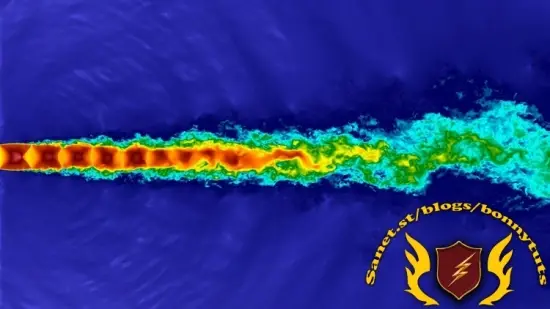Applied Physics For Engineering II: Thermofluids
Thermofluids and Heat Transfer for Engineering Applications
What you'll learn
Explain the fundamental laws of thermodynamics, including energy conservation, heat transfer, entropy, and their applications in real-world systems.
Evaluate fluid properties like density, viscosity, and surface tension, and apply the Bernoulli and Navier-Stokes equations.
Identify and analyze modes of heat transfer; Conduction, convection, and radiation and their implications in steady state and transient thermal systems.
Utilize thermofluid principles to assess and optimize the performance of engineering systems, including HVAC, thermal management and aerodynamics

Requirements
B.S or graduate students, Mechanical engineering, Manufacturing Engineering, Aerospace Engineering, Electronics Engineering, Physics, Technicians with industry experience.
Description
Welcome to Applied Physics For Engineering Design II, As a second part on the series, this course provides an exploration of thermodynamics, fluid mechanics, and heat transfer, emphasizing their practical applications in engineering design. It begins with the fundamentals of thermodynamics, covering system properties, the first and second laws, and an introduction to statistical mechanics for a microscopic understanding of thermodynamic behavior.
The course then delves into fluid mechanics and flow dynamics, discussing essential fluid properties, Bernoulli’s equation, and the Navier-Stokes equations, which govern fluid motion. The transition between laminar and turbulent flows is analyzed, with a focus on its implications for engineering systems and industrial processes.In the heat transfer module, students explore conduction, convection, and radiation, examining both steady-state and transient heat conduction. Forced and natural convection principles are applied to cooling systems, and radiation heat transfer is discussed in the context of black body radiation and energy applications.
The final module integrates these concepts into real-world engineering design, covering HVAC systems, thermal management in electronics, vehicle and aircraft aerodynamics, and industrial energy systems such as boilers and heat exchangers. By the end of the course, students will develop a comprehensive understanding of thermofluid principles and their role in optimizing engineering applications, improving system efficiency, and solving complex thermal challenges.
Who this course is for
Engineers, senior or grad students. Entrepreneurs and Innovators, designers, manufacturing professionals (with our without a college degree). Overall, Professionals Seeking Career Growth
Published 2/2025
Created by Pedro Portugal
MP4 | Video: h264, 1280x720 | Audio: AAC, 44.1 KHz, 2 Ch
Level: Intermediate | Genre: eLearning | Language: English | Duration: 20 Lectures ( 3h 8m ) | Size: 1.03 GB
Download
*
Thermofluids and Heat Transfer for Engineering Applications
What you'll learn
Explain the fundamental laws of thermodynamics, including energy conservation, heat transfer, entropy, and their applications in real-world systems.
Evaluate fluid properties like density, viscosity, and surface tension, and apply the Bernoulli and Navier-Stokes equations.
Identify and analyze modes of heat transfer; Conduction, convection, and radiation and their implications in steady state and transient thermal systems.
Utilize thermofluid principles to assess and optimize the performance of engineering systems, including HVAC, thermal management and aerodynamics

Requirements
B.S or graduate students, Mechanical engineering, Manufacturing Engineering, Aerospace Engineering, Electronics Engineering, Physics, Technicians with industry experience.
Description
Welcome to Applied Physics For Engineering Design II, As a second part on the series, this course provides an exploration of thermodynamics, fluid mechanics, and heat transfer, emphasizing their practical applications in engineering design. It begins with the fundamentals of thermodynamics, covering system properties, the first and second laws, and an introduction to statistical mechanics for a microscopic understanding of thermodynamic behavior.
The course then delves into fluid mechanics and flow dynamics, discussing essential fluid properties, Bernoulli’s equation, and the Navier-Stokes equations, which govern fluid motion. The transition between laminar and turbulent flows is analyzed, with a focus on its implications for engineering systems and industrial processes.In the heat transfer module, students explore conduction, convection, and radiation, examining both steady-state and transient heat conduction. Forced and natural convection principles are applied to cooling systems, and radiation heat transfer is discussed in the context of black body radiation and energy applications.
The final module integrates these concepts into real-world engineering design, covering HVAC systems, thermal management in electronics, vehicle and aircraft aerodynamics, and industrial energy systems such as boilers and heat exchangers. By the end of the course, students will develop a comprehensive understanding of thermofluid principles and their role in optimizing engineering applications, improving system efficiency, and solving complex thermal challenges.
Who this course is for
Engineers, senior or grad students. Entrepreneurs and Innovators, designers, manufacturing professionals (with our without a college degree). Overall, Professionals Seeking Career Growth
Published 2/2025
Created by Pedro Portugal
MP4 | Video: h264, 1280x720 | Audio: AAC, 44.1 KHz, 2 Ch
Level: Intermediate | Genre: eLearning | Language: English | Duration: 20 Lectures ( 3h 8m ) | Size: 1.03 GB
Download
*